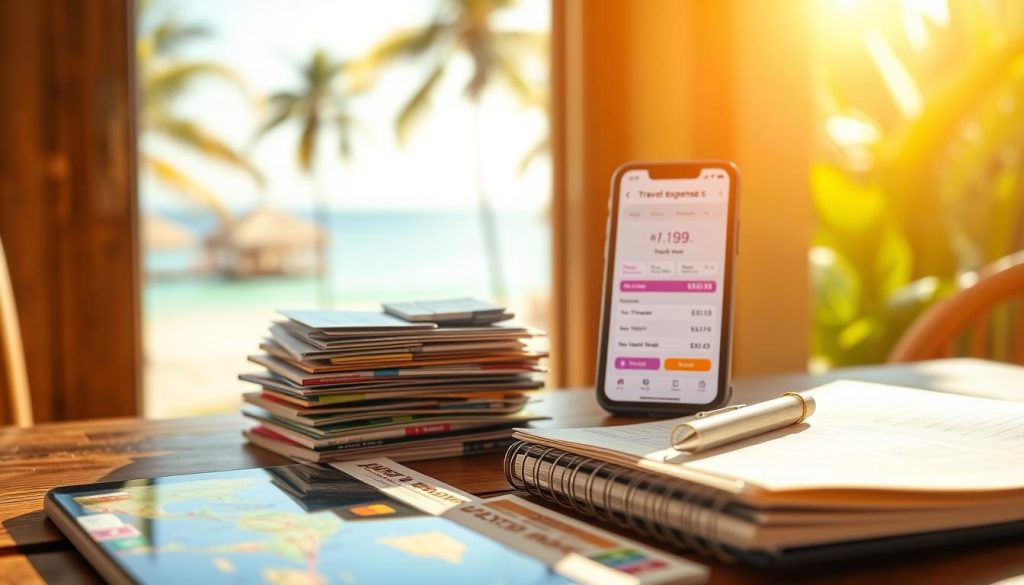✓ Accommodations✓ Flights✓ Rental Cars✓ Tours & Activities
Planning a trip to Cape Verde? Managing your money wisely can make or break your experience. The local currency, the Cape Verdean Escudo (CVE), is essential for everyday transactions, and understanding exchange rates is key to saving money.
Whether you’re using cash, a card, or a digital travel card, this guide will help you navigate the best payment methods. You’ll learn how to avoid hidden fees, find the best exchange rates, and budget effectively for your trip.
From actionable tips on currency exchange to the benefits of using a Wise travel card, this guide is packed with reliable information to make your journey seamless. Ready to explore? Let’s dive in!
Introduction to Cape Verde’s Currency Landscape
Navigating the financial landscape of Cape Verde starts with its official currency. The Cape Verdean Escudo (CVE) is the backbone of the country’s economy and essential for everyday transactions. Whether you’re shopping at local markets or dining at restaurants, understanding this currency will make your trip smoother.
What is the Cape Verdean Escudo?
The Cape Verdean Escudo is the official currency of Cape Verde, symbolized as CVE. It’s divided into 100 centavos, though centavo coins are rarely used today. The currency is pegged to the euro at a fixed rate of approximately 110 CVE to 1 euro. This stability makes it easier for travelers to plan their budgets.
Key Facts and Figures
Here are some essential details about the Cape Verdean Escudo:
- The currency code is CVE, and it’s issued by the Central Bank of Cape Verde.
- Denominations include coins of 1, 5, 10, 20, 50, and 100 CVE, and banknotes of 200, 500, 1000, 2000, and 5000 CVE.
- The fixed exchange rate with the euro ensures consistency in value, which is particularly helpful for travelers from Eurozone countries.
Understanding these details can help you avoid common pitfalls when exchanging money. For example, knowing the fixed rate can prevent you from overpaying at currency exchange offices. “Knowledge is power, especially when it comes to managing your travel budget,” as the saying goes.
In tourist hubs like Sal and Santiago, the Cape Verdean Escudo is widely accepted. However, some businesses may also accept euros, though it’s always better to have local currency for smaller transactions. By familiarizing yourself with the Cape Verdean Escudo, you’ll be well-prepared to explore the islands without financial stress.
Preparing Your Travel Money in Advance
Getting your travel money ready before your trip can save you time and stress. Exchanging currency in advance ensures you’re prepared for immediate expenses like transportation or meals. It also helps you avoid the higher fees often charged at airports or hotels.

Benefits of Exchanging Before Departure
Exchanging your money before you leave has several advantages. You’ll likely secure better rates compared to last-minute exchanges. Local banks or credit unions often offer more competitive rates than airport kiosks. This small step can make a big difference in your travel budget.
Another benefit is convenience. Having local cash on hand means you won’t waste time searching for ATMs or currency exchange spots upon arrival. It’s especially helpful in areas where card payments aren’t widely accepted.
Tips for Exchanging USD to CVE
When exchanging USD to CVE, start by comparing mid-market rates online. This gives you a benchmark to ensure you’re getting a fair deal. Avoid exchanging large sums at airports, as their rates are often less favorable.
Here are a few more tips to keep in mind:
- Use trusted banks or online platforms for currency exchange.
- Check for hidden fees, such as service charges or delivery costs.
- Carry a mix of cash and cards for flexibility.
By planning your money strategy in advance, you’ll save both time and money. This approach lets you focus on enjoying your trip without worrying about financial hiccups.
Understanding Live Exchange Rates and Markups
Understanding exchange rates is crucial for managing your travel budget effectively. The rate you see online isn’t always the rate you’ll get when exchanging money. This is because banks and currency providers add markups and fees, which can significantly increase your costs.
Mid-Market vs. Offered Rates
The mid-market rate is the rate banks use when trading currencies among themselves. It’s considered the fairest rate because it doesn’t include markups. However, when you exchange money, you’ll likely be offered a less favorable rate. This is known as the offered rate.
For example, if the mid-market rate for USD/CVE is 110, your provider might offer you 105. The difference between these rates is the markup, which is how providers make a profit. Always compare the offered rate to the mid-market rate to avoid overpaying.
How to Track the USD/CVE Rate
Tracking live exchange rates is easier than ever. Use online currency converters or apps to monitor the USD/CVE rate in real time. These tools often display the mid-market rate, giving you a benchmark to compare against your provider’s rate.
Here’s a quick guide to tracking rates effectively:
- Check the mid-market rate before exchanging money.
- Compare your provider’s rate to the mid-market rate.
- Look for hidden fees, such as service charges or delivery costs.
| Provider | Markup | Fee |
|---|---|---|
| Wise | -0.62% | $23.34 |
| Revolut | 0.2% | $0 |
| Ria Money Transfer | 2.8% | $4 |
Using a secure account with a reputable service can also save you money. Providers like Wise and Revolut offer competitive rates and low fees, making them ideal for managing transactions abroad. By staying informed and comparing rates, you can ensure you’re getting the best deal on your currency exchange.
Cape Verde: Ultimate Travelers Guide to Currencies & Payments
Managing your finances while traveling can be simple with the right tools. In Cape Verde, you’ll find a mix of cash, card, and digital payment options. Each method has its advantages, and using a combination ensures you’re prepared for any situation.

Why Use Cash and Cards Together?
Carrying cash is essential for small purchases, like street food or local markets. Many smaller vendors don’t accept cards, so having local currency on hand is a must. On the other hand, cards are convenient for larger expenses, such as hotels or restaurants.
Digital solutions, like the Wise travel card, offer flexibility. They allow you to load multiple currencies and avoid high fees. “Blending payment methods ensures you’re never caught off guard,” as seasoned travelers often say.
The Benefits of a Wise Travel Card
The Wise travel card is a game-changer for managing your money abroad. It offers competitive exchange rates and low fees, making it a cost-effective choice. You can load it with euros or dollars and convert them to CVE at the mid-market rate.
Here’s how it compares to other options:
| Provider | Exchange Rate | Fee |
|---|---|---|
| Wise | Mid-market | $1.50 |
| Bank | Marked up | $10+ |
| Airport Kiosk | Marked up | $15+ |
Using a travel card like Wise can save you money and simplify your payments. It’s especially useful for frequent travelers who want to avoid carrying large amounts of cash.
By combining cash, cards, and digital solutions, you’ll have the flexibility to handle any transaction. This approach ensures you’re prepared for both small and large expenses, making your trip smoother and more enjoyable.
Navigating Payment Methods in Cape Verde
When exploring the islands, knowing how to handle your money is key. Whether you’re shopping at local markets or dining at restaurants, understanding the available payment options ensures a smooth experience. Here’s what you need to know about using debit and credit cards, as well as the importance of carrying cash.
Debit and Credit Card Usage
Many hotels, restaurants, and larger stores in Cape Verde accept debit and credit cards. Visa and Mastercard are widely recognized, making them convenient for travelers. However, it’s always a good idea to inform your bank about your travel plans to avoid any issues with international transactions.
While cards are handy, they may not be accepted everywhere. Smaller vendors, especially in rural areas, often prefer cash. Additionally, some businesses may charge a small fee for card payments, so it’s wise to carry some local currency for flexibility.
Cash Acceptance and Merchant Preferences
Cash remains the preferred payment method for many merchants, particularly in smaller shops and local markets. Having cash on hand is also essential for tipping or purchasing small items like snacks or souvenirs. “When in doubt, cash is king,” as seasoned travelers often say.
To avoid high fees, withdraw cash from ATMs in larger towns or cities. Always choose to be charged in the local currency to avoid poor exchange rates. Here’s a quick comparison of popular ATM options:
| Provider | Fee per Withdrawal | Exchange Rate |
|---|---|---|
| Wise | $1.50 | Mid-market |
| Local Bank | $3.00 | Marked up |
| Airport ATM | $5.00+ | Marked up |
By combining card and cash payments, you’ll be prepared for any situation. This approach ensures you can enjoy your trip without worrying about financial hiccups.
Budgeting Your Trip: Daily Expenses and Costs
Creating a realistic budget for your trip ensures you can enjoy every moment without financial stress. Knowing the typical daily costs for accommodation, food, and activities helps you plan your spending wisely. Whether you’re a budget traveler or prefer luxury, this guide will help you estimate your expenses accurately.

Accommodation and Food Prices
Your choice of hotel or rental can significantly impact your budget. Budget travelers can find accommodations for around $29 per night, while mid-range options average $67. For a more luxurious stay, expect to pay $128 or more per night.
Food costs also vary. Budget meals, like local dishes, can cost as little as $13 per day. Mid-range dining averages $30, and luxury meals can reach $60 daily. “Exploring local cuisine is a highlight of any trip, but planning your food budget ensures you don’t overspend,” as experienced travelers often say.
Estimating Travel and Attraction Expenses
Transportation and activities are another key part of your spending. Shared taxis are affordable, with fares ranging from $1 to $5. Attractions and entertainment typically cost around $17 per day, making it easy to enjoy the islands without breaking the bank.
Here’s a breakdown of average daily costs for different travel styles:
| Travel Style | Daily Cost | Weekly Cost |
|---|---|---|
| Budget | $63 | $441 |
| Mid-Range | $143 | $1,001 |
| Luxury | $274 | $1,918 |
By comparing prices and planning ahead, you can make the most of your trip without overspending. This approach ensures you have enough money for unforgettable experiences while staying within your budget.
Using Euros in Cape Verde: A Dual Currency Approach
Carrying both Euros and local currency can simplify your travels in Cape Verde. The dual-currency approach offers flexibility, especially in areas where the Cape Verdean Escudo (CVE) is the primary legal tender. This strategy ensures you’re prepared for any spending scenario, from local markets to tourist hubs.
Advantages of Carrying Euros
Euros are widely accepted across the islands, making them a practical option for travelers. The fixed exchange rate of approximately 110 CVE per Euro adds stability to your budget. This means you can easily convert Euros to CVE without worrying about fluctuating rates.
Here’s why this approach works:
- Flexibility in spending: Use Euros for larger transactions and CVE for smaller purchases.
- Simplified transactions: Many businesses, especially in tourist areas, accept both currencies.
- Minimized risks: Having two currencies ensures you’re never stranded without a payment option.
To make the most of this strategy, convert a portion of your funds upon arrival. ATMs in larger towns offer competitive exchange rates, and banks are reliable for currency conversion. “A dual-currency approach is like having a financial safety net,” as experienced travelers often say.
By carrying both Euros and CVE, you’ll enjoy a seamless experience while exploring Cape Verde. This method not only saves time but also reduces the stress of managing your money cape during your trip.
Tips for Safe Transactions and Money Management
Keeping your money safe while traveling is essential for a stress-free experience. Whether you’re using cash, cards, or digital payments, following these tips will help you avoid common pitfalls and manage your funds securely.

Avoiding Dynamic Currency Conversion
When paying by card abroad, you might encounter dynamic currency conversion (DCC). This service allows merchants to charge you in your home currency instead of the local one. While it sounds convenient, it often comes with poor exchange rates and hidden fees.
To avoid this, always choose to be charged in the local currency. Most card terminals will give you the option. “Opting for local currency ensures you get the best rate,” as financial experts advise.
Strategies for Securing Your Money On the Go
Protecting your cash and cards is crucial when traveling. Here are some effective strategies:
- Split your funds: Carry cash and cards in different locations, such as a money belt and a secure bag.
- Use a travel card: Multi-currency cards like Wise offer low fees and competitive rates, making them a safer alternative to carrying large amounts of cash.
- Keep digital backups: Store scanned copies of important documents, like your passport and card details, in a secure cloud service.
Here’s a comparison of popular travel card options:
| Provider | Foreign Transaction Fee | Exchange Rate |
|---|---|---|
| Wise | 0.5% | Mid-market |
| Chase Sapphire Preferred | 3% | Marked up |
| NetSpend | 4% | Marked up |
By following these tips, you can minimize risks and focus on enjoying your trip. Proper money management ensures you’re prepared for any situation, from small purchases to unexpected expenses.
Optimizing Your Payment Strategy with Travel Cards
Maximizing your payment options while traveling can save you time and money. A travel debit card is one of the most efficient tools for managing your finances abroad. These cards offer flexibility, security, and cost savings, making them a must-have for any trip.
Benefits of a Multi-Currency Travel Card
A multi-currency travel card allows you to hold and spend in multiple currencies without high conversion fees. This is especially useful in destinations where the local currency differs from your home currency. “With a multi-currency card, you can avoid the hassle of carrying cash and enjoy better exchange rates,” as financial experts often recommend.
Here’s why these cards are a game-changer:
- Low foreign transaction fees: Save money on every purchase.
- Competitive exchange rates: Access mid-market rates for better value.
- Convenience: Use one card for all your card payment needs.
Minimizing Foreign Transaction Fees
One of the biggest advantages of a travel debit card is its ability to minimize foreign transaction fees. Traditional banks often charge up to 3% per transaction, but multi-currency cards like Wise offer rates as low as 0.5%. This can add up to significant savings over time.
Here’s a comparison of popular card providers:
| Provider | Foreign Transaction Fee | Exchange Rate |
|---|---|---|
| Wise | 0.5% | Mid-market |
| Chase Sapphire Preferred | 3% | Marked up |
| NetSpend | 4% | Marked up |
By choosing the right card provider, you can streamline your spending and avoid unnecessary costs. “A little research goes a long way in saving money,” as seasoned travelers often say.
Integrating a travel debit card into your payment strategy ensures you’re prepared for any financial situation. Whether you’re dining out or shopping, these cards offer a secure and cost-effective option for managing your money abroad.
Conclusion
To make the most of your journey, planning your money strategy is essential. Reviewing exchange rates and budgeting for costs ensures you’re prepared for every transaction. Choosing the right provider for your account can save you both time and hassle.
Using a Wise travel card and a dual-currency approach simplifies your trip. These methods offer flexibility and help you avoid unnecessary fees. Whether you’re a tourist or a seasoned traveler, these tips will make your experience smoother.
Stay informed, plan ahead, and enjoy a stress-free adventure in this beautiful part of the world. With the right preparation, you can focus on creating unforgettable memories.
The above is subject to change.
Check back often to TRAVEL.COM for the latest travel tips and deals.






